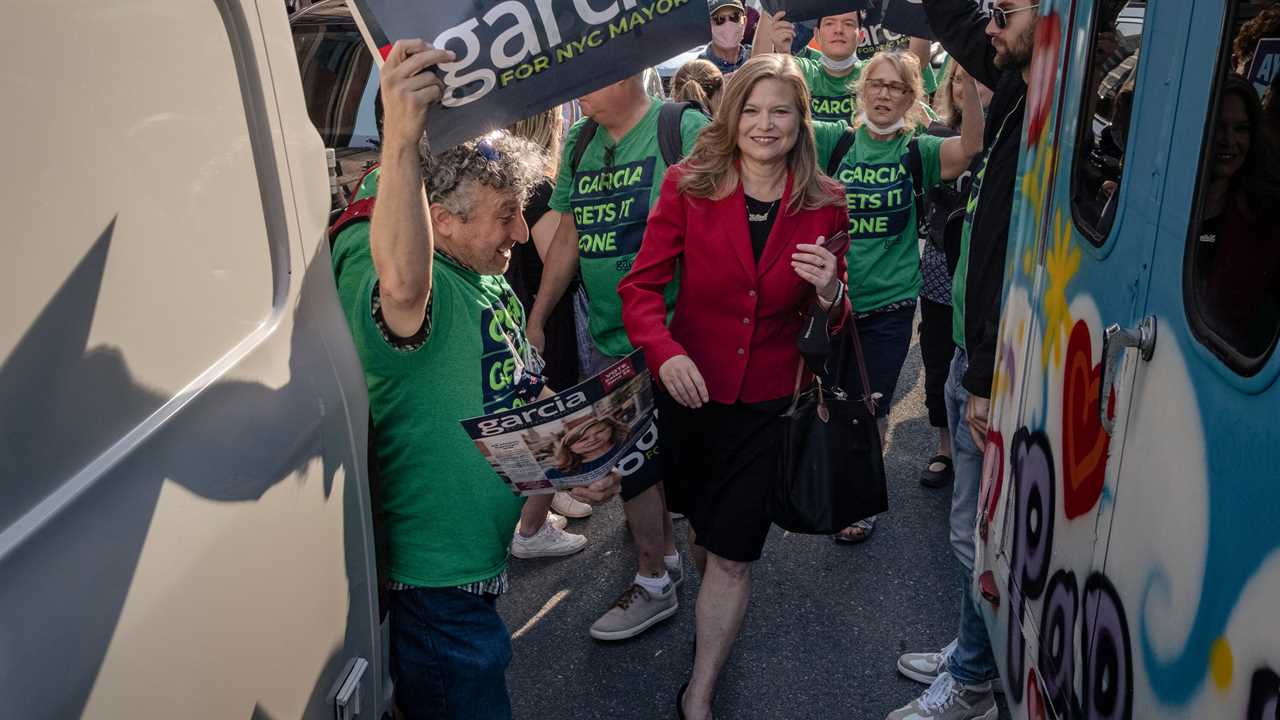
Early voting in the mayoral primary began Saturday, but given how few New Yorkers have yet to show up at their polling sites, it looks like the candidates still have time to get their messages out before 9 p.m. on June 22.
For all of those invested in a healthy turnout, the early numbers do not bode particularly well. Just 16,867 voters showed up on Saturday, according to the Board of Election’s unofficial tally.
Every New Yorker who has yet to cast a vote is still theoretically persuadable. And the candidates are sparing no expense in trying to reach them.
Garcia out-raises field, and Adams outspends it
In the final weeks of the mayor’s race, donations have poured in to the campaign of Kathryn Garcia, a former sanitation commissioner who has risen from long shot to viable leading candidate.
In the three weeks ending June 7, Ms. Garcia raised $703,000, more than in the prior two months combined. She narrowly edged out Eric Adams, the Brooklyn borough president, who raised $618,000, and far surpassed the former presidential candidate Andrew Yang’s haul of $437,000. Her donors included the cookbook author Jessica Seinfeld and the real estate developer Hal Fetner, who worked with Ms. Garcia when she was the interim chair of the New York City Housing Authority.
“It means that we will have the resources we need in this final push to the end to make sure we’re getting our message out,” said Ms. Garcia, when reached by phone on Sunday.
She said much of the money will go toward ads on TV, a medium now saturated with political messaging.
Since January, politicians and their affiliated super PACs have spent more than $49 million on TV, radio and digital advertising, according to Ad Impact, an advertising analytics firm.
After the super PAC supporting the former federal housing secretary Shaun Donovan, which is largely funded by his father, the highest spenders on advertising have been the campaigns of Mr. Adams and Scott M. Stringer, the city comptroller. In the filing period that concluded last week, the biggest spender for all things, advertising included, was the Adams campaign, which spent $5.9 million over three weeks. Next was the Yang campaign, which spent $3.4 million.
Evan Thies, a spokesman the Adams campaign, said that Mr. Adams has already raised as much as he can under city campaign finance limits, and there was no reason to hold back.
“He no longer needs to keep raising money,” Mr. Thies said.
Giuliani backs Sliwa
Former Mayor Rudolph W. Giuliani waded into the Republican mayoral primary last week, endorsing Curtis Sliwa in a race that has divided the party’s leaders and voters.
In a robocall, the former mayor called Mr. Sliwa, the founder of the Guardian Angels, my “great friend” going back to the 1990s.
“When I ran for mayor,” Mr. Giuliani said, “Curtis and the Guardian Angels were there to help me win, and then they were there to help me reduce crime and make our city livable again.”
Mr. Sliwa is running in a bitterly fought primary against Fernando Mateo, an entrepreneur who was recently endorsed by Michael T. Flynn, a former national security adviser to President Donald J. Trump.
The race appears to be close. Mr. Sliwa had 33 percent support and Mr. Mateo had 27 percent, while 40 percent were undecided, according to a recent poll by Pix 11 and Emerson College.
Party leaders are split as well. Republican leaders in Manhattan, Queens and the Bronx endorsed Mr. Mateo. The Staten Island and Brooklyn parties backed Mr. Sliwa.
There are 13 candidates on the Democratic ballot, but Republican voters only have two choices, and Mr. Sliwa jokingly offered a simple guide: He told voters to mark the dot next to the name Sliwa, not “Mr. Irrelevant.”
Old Adams video causes kerfuffle
In February, Mr. Adams said something that would come back to haunt him four months later.
During an interview with the Citizens Budget Commission, Mr. Adams was talking about some of his spending proposals, like year-around school, and how he might find efficiencies in government to help pay for them, when he turned to the potential of remote learning.
“If you do a full-year school year by using the new technology of remote learning, you don’t need children to be in a school building with a number of teachers,” he said, echoing comments he also made to Bloomberg. “It’s just the opposite. You could have one great teacher that’s in one of our specialized high schools to teach three to four hundred students who are struggling in math, with the skillful way that they’re able to teach.”
Mr. Adams appeared to be just spitballing. But on Friday, an ardent Yang supporter who goes by @ZachandMattShow on Twitter posted a cut of the video and a paraphrasing of Mr. Adam’s comments that did not mention elite high schools or particularly skillful teachers.
The tweet went viral, sparking condemnation from the Yang campaign, as well as from Representative Alexandria Ocasio-Cortez, who is backing Maya Wiley, a former counsel to Mayor Bill de Blasio, and suggested that Mr. Adams wanted to defund schools.
Ms. Wiley chimed in, too.
“All I can say is, Eric Adams, what did we not understand before Covid about our digital divide?” asked Ms. Wiley, during a campaign appearance. “We’ve been talking about it for decades.”
Asked for comment, Mr. Thies, the Adams spokesman, said the Brooklyn borough president’s quotes were taken out of context and improperly transcribed on Twitter.
“All of this is a massive distraction from the truth, which is that Eric has never supported requiring students to attend 100-plus person classes online, and would never require that as mayor,” Mr. Thies said. “Nor would he require teachers to teach large classes.”






